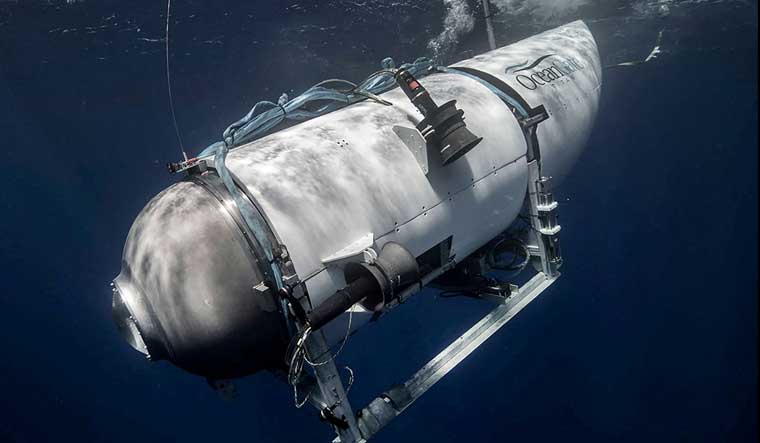Rescuers continued their frantic search for the missing tourist submersible Titan on Wednesday as oxygen supply dwindled for the five men onboard the vessel which was on a mission to explore the wreckage of the Titanic. There has been no sight of the submersible yet though a Canadian search aircraft reportedly detected "banging" in 30-minute intervals from the area where the vessel disappeared.
Earlier reports had claimed that the search crew heard banging at 30-minute intervals, and a Canadian P3 aircraft also located a white rectangular object in the water. But the US Coast Guard later tweeted that the subsequent searches "yielded negative results."
"Canadian P-3 aircraft detected underwater noises in the search area. As a result, ROV operations were relocated in an attempt to explore the origin of the noises. Those ROV searches have yielded negative results but continue," the Coast Guard said in a tweet.
"Additionally, the data from the P-3 aircraft has been shared with our US Navy experts for further analysis which will be considered in future search plans."
Canadian P-3 aircraft detected underwater noises in the search area. As a result, ROV operations were relocated in an attempt to explore the origin of the noises. Those ROV searches have yielded negative results but continue. 1/2
— USCGNortheast (@USCGNortheast) June 21, 2023
The 21-foot-long vessel is equipped with four days (96 hours) of emergency capability, which means there would be an oxygen supply only until Thursday. Onboard Titan is renowned British adventurer Hamish Harding, Pakistani businessman Shahzada Dawood and his son Suleman, a French diving expert Paul-Henry Nargeolet and OceanGate chief executive Stockton Rush.
Meanwhile, the search continues. U.S. Coast Guard Captain Jamie Frederick said the U.S. and Canadian aircraft have searched more than 7,600 square miles of open sea, an area larger than the state of Connecticut. "The Canadian military has dropped sonar buoys to listen for any sounds that might come from the Titan, and a commercial vessel with a remote-controlled deepwater submersible was also searching near the site," Frederick said.
More rescue teams have joined the search, including deep sea mapping company Magellan, known for its one-of-a-kind deep sea imagery of the Titanic. Magellan crew joined the rescue operations after it was contacted by OceanGate early on Monday. Besides US Navy experts and a 'Flyaway Deep Ocean Salvage System' that can lift small vessels, a French research ship with expertise in deep-sea diving robots has also been dispatched to the search area.
The Titan submersible lost contact with the research vessel Polar Prince approximately 1,450km east and 643km south of Newfoundland's capital, St John's, in Canada. The communication was lost within one hour and 45 minutes into its two-hour dive down to the Titanic wreck site which lies at a depth of 3,800m. There was reportedly an 8-hour delay in notifying the Coast Guard about the issue.
Meanwhile, oceanographers said that the rescuers faced multiple challenges, both in finding the Titan and rescuing the people. "If the submersible experienced a mid-dive emergency, the pilot would likely have released weights to float back to the surface," Alistair Greig, a marine engineering professor at University College London, told Reuters.
"But absent communication, locating a van-sized submersible in the vast Atlantic could prove challenging," he added.
Even if the submersible manages to surface, the occupants can't let themselves out as the submersible is sealed with bolts from the outside. If Titan is stuck on the ocean floor or tangled in the wreck of Titanic, it would be even more challenging to excavate the vessel due to the extreme conditions more than 2 miles beneath the surface.
The Titanic lies 12,500 feet (3,810 meters) underwater, where no sunlight penetrates and the technology to reach that depth is limited as the water pressure is too high. "It's really a bit like being an astronaut going into space," said Tim Matlin, a Titanic expert. "I think if it's on the seabed, there are so few submarines that are capable of going that deep. And so, therefore, I think it was going to be almost impossible to effect a sub-to-sub rescue."










